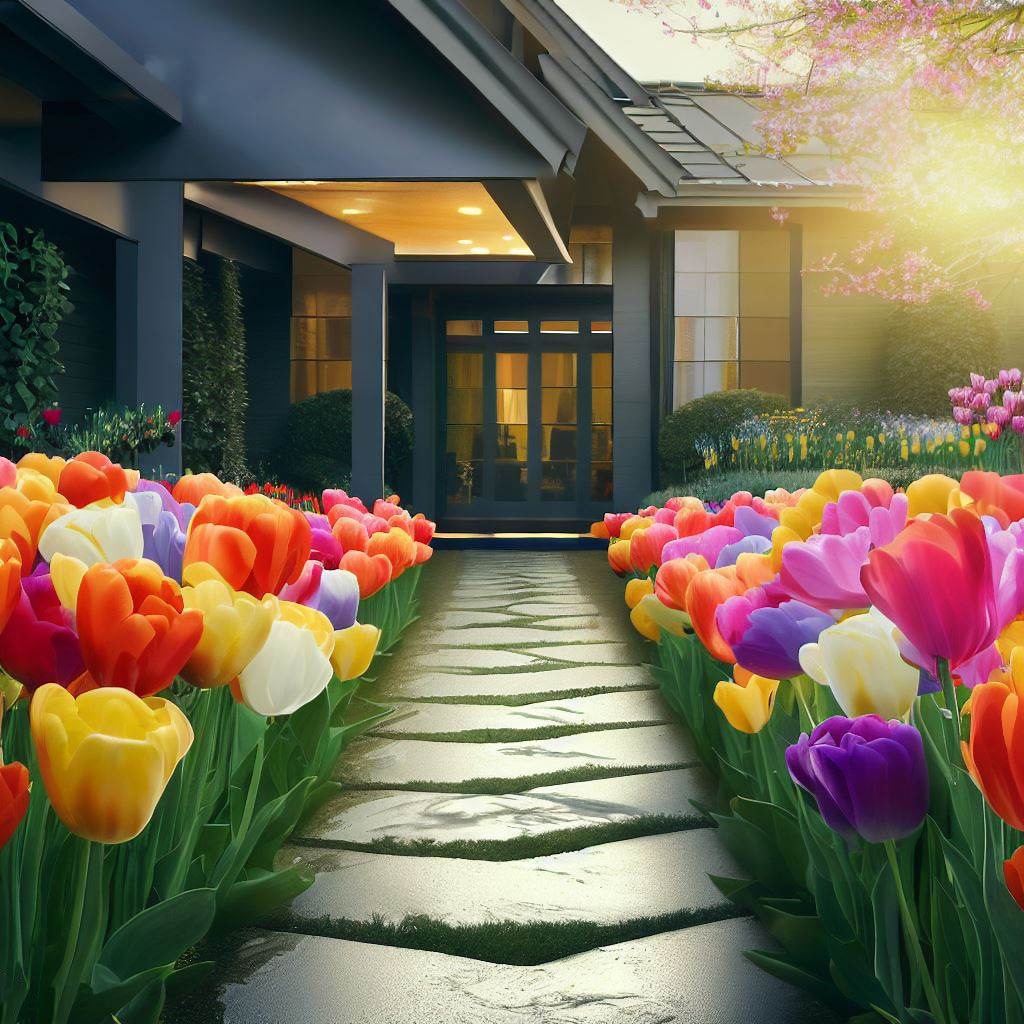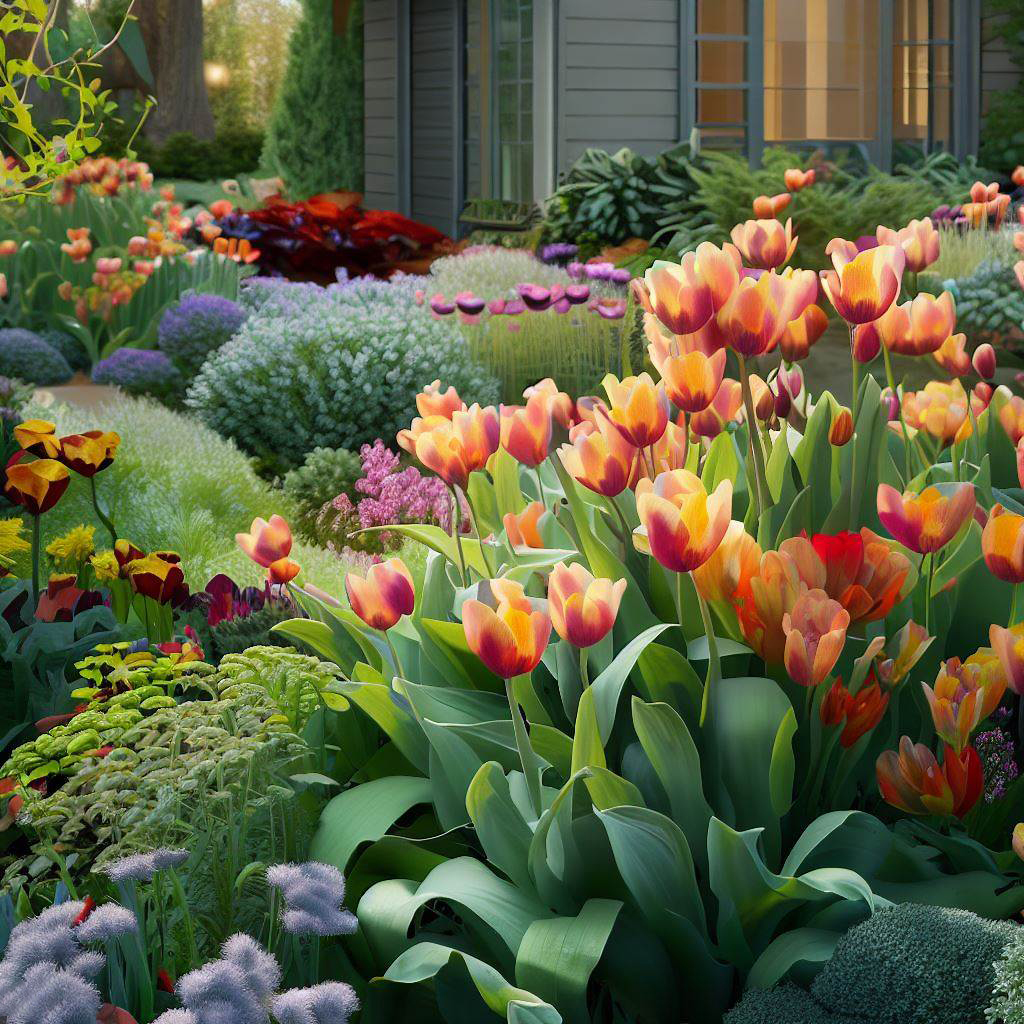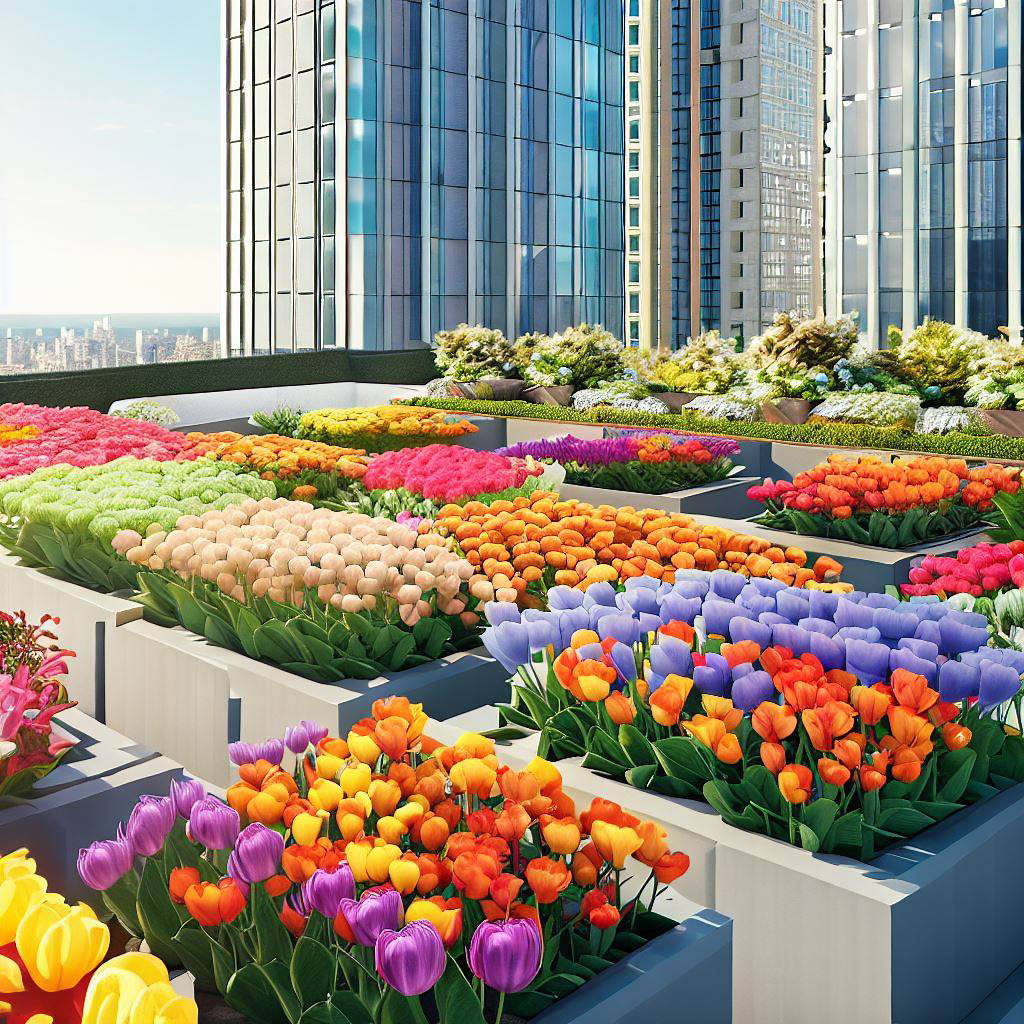Transform your outdoor space into a colorful paradise with these inspiring tulip garden ideas and expert planting advice. From popular designs to unique color combinations and small space solutions, this guide will help you create a breathtaking tulip display in your garden.
Table of Contents
- Popular Tulip Garden Designs
- Choosing the Right Tulip Varieties and Color Combinations
- Companion Plants for Tulips
- Planting and Caring for Tulips
- Tulip Gardens in Small Spaces and Containers
- Conclusion
Popular Tulip Garden Designs
With their vibrant colors and graceful shapes, Tulips have long been cherished as the quintessential spring flower. They possess a captivating allure that can bring beauty and joy to any garden. If you’re looking to infuse your garden with the charm of tulips, numerous design ideas can inspire your creative instincts. Let’s explore some popular tulip garden designs that can transform your outdoor space into a blooming masterpiece:
Clusters and Drifts: A Symphony of Colors
One way to create a truly captivating tulip garden is to plant them in clusters or drifts of similar colors. Imagine a bed of tulips showcasing a harmonious blend of deep reds, vibrant yellows, or delicate pinks. This design choice amplifies the flowers’ visual impact and creates a sense of cohesion and unity within the garden. By grouping tulips of the same color, each hue can shine brightly, captivating the eyes and drawing attention to the intricate details of each blossom. Such an arrangement will delight any observer’s imagination, making your garden an irresistible beauty haven.
Mixed Tulip Varieties: A Tapestry of Contrasts
For those seeking a garden design that is visually striking and brimming with diversity, mixing different tulip varieties is the way to go. Experiment with various tulip types, ranging from elegant and straightforward single tulips to abundant and elaborate double and fringed tulips. Combining these distinct varieties allows you to create an eye-catching display that enchants the senses. Imagine the interplay of contrasting colors, shapes, and textures as the tulips gracefully bloom side by side. This design choice allows you to showcase the full spectrum of tulip beauty and guarantees a garden that stands out and leaves a lasting impression.
Layered Bulb Plantings: A Symphony Across Seasons
If you crave a tulip garden with a prolonged and multi-layered display of beauty, consider incorporating layered bulb plantings. By combining tulips with other spring-blooming bulbs, such as daffodils and hyacinths, you can create a dynamic garden that boasts a succession of blooms throughout the season. Plant the bulbs at varying depths to stagger their bloom times, ensuring a continuous show of vibrant colors and delightful fragrances. Picture a garden where tulips emerge gracefully, followed by daffodils, and finally hyacinths, creating a symphony of blossoms that transforms your garden into a floral paradise. With layered bulb plantings, you can savor the joy of spring for an extended period as each new wave of blooms unfolds.
The possibilities for designing a stunning tulip garden are as vast and varied as the tulip itself. Whether you cluster them together, mix and contrast different varieties, or create a layered display of bulb plantings, tulips will surely add enchantment to your outdoor sanctuary. So let your creativity flourish, and let your tulip garden become a testament to the wonders of nature’s artistry.

Here’s an external source for more tulip garden design ideas
Choosing the Right Tulip Varieties and Color Combinations
When creating a tulip garden that genuinely shines, selecting suitable varieties and color combinations is of utmost importance. These choices can make all the difference in achieving a harmonious and visually appealing display. Here are some helpful tips to guide you in making the best decisions for your garden:
Bloom Time: A Symphony of Continuous Blooms
To ensure a captivating tulip garden that delights the eye throughout the spring, choosing tulip varieties with varying bloom times is essential. Select a combination of early, mid, and late-season tulips to create a continuous spectacle of color. Imagine the beauty of early tulips bursting into bloom, the emergence of mid-season tulips, and finally culminating in the grand finale of late-season tulips. This thoughtful selection guarantees a prolonged flowering period, extending the enjoyment of your tulip garden and captivating visitors with an ever-changing landscape.
Flower Form: Adding Visual Interest and Drama
Experimenting with different tulip flower forms can elevate your garden design and add a touch of visual intrigue. Tulips come in various shapes, single, double, and fringed. Each state possesses its unique charm and character. Single tulips feature classic, elegant blooms with a single layer of petals, while double tulips boast luxurious, densely packed petals, creating a lush and opulent appearance. Fringed tulips exhibit delicately fringed or serrated edges, adding a whimsy texture to the garden. By incorporating a mix of these flower forms, you can create a dynamic and captivating display that sparks curiosity and draws the eye.
Color Palette: Harmonizing Beauty
Choosing the right color palette for your tulip garden is essential for achieving a harmonious and visually pleasing composition. Consider both your existing plantings and your personal preferences when selecting tulip colors. Consider the colors of nearby flowers, shrubs, or trees in your garden, and choose tulips that complement these existing elements. You can opt for a complementary color scheme, pairing tulips of opposite hues on the color wheel, such as red and green or purple and yellow, to create a vibrant and visually striking contrast. Alternatively, you may prefer an analogous color scheme, combining tulips of similar shades, such as various hues of pink or purple, for a more harmonious and soothing effect. Striking a balance between bold and soft colors can also contribute to an aesthetically pleasing garden design. The key is creating a color palette that resonates with your taste and creates a unified and cohesive look in your garden.
Companion Plants for Tulips
When designing your tulip garden, selecting the perfect companion plants can elevate its beauty and create a truly enchanting landscape. The ideal companions for tulips are those that offer contrasting shapes, textures, or bloom times, complementing the tulips and enhancing their overall appeal. Here are some popular options to consider:
Daffodils: A Timeless Duo
Daffodils and tulips are classic companions, creating a captivating display of spring blooms. Daffodils, with their vibrant yellow or white petals and distinctive trumpet-shaped centers, complement the graceful forms of tulips. They also provide a contrasting color palette that adds depth and visual interest to the garden. Planting daffodils alongside tulips allows you to extend the blooming period and enjoy a longer-lasting burst of springtime beauty.
Hyacinths: Fragrant Harmony
The intoxicating fragrance and charming flower spikes of hyacinths make them an excellent choice as companion tulip plants. Hyacinths come in various colors, ranging from deep purples and blues to soft pinks and whites, allowing for endless combinations with tulip hues. Placing hyacinths near tulips adds visual appeal and fills the air with their delightful scent, creating an immersive sensory experience in your garden.
Alliums: Striking Elegance
Consider pairing tulips with alliums for a touch of architectural elegance and drama. Alliums feature unique spherical flower heads atop tall, slender stems, adding vertical interest and texture to the garden. Their blooms come in purple, pink, and white shades, creating a stunning contrast against the tulip flowers. The combination of tulips and alliums can create a visually striking composition that captivates attention and leaves a lasting impression.
Pansies: Charming Color Harmony
Pansies, with their cheerful and vibrant blossoms, are excellent tulip companions, offering a harmonious blend of colors. These petite flowers come in various hues, including purples, blues, yellows, oranges, and more. You can create a charming and colorful tapestry that enlivens your garden by planting pansies alongside tulips. Pansies also have the advantage of being cool-season plants, making them an ideal choice for early spring tulip companions.
Forget-me-nots: Delicate Beauty
The delicate, sky-blue flowers of forget-me-nots can provide a soft and enchanting backdrop for your tulip garden. These dainty blooms create a carpet of color beneath the tall tulip stems, adding a touch of whimsy and charm. Forget-me-nots also have a spreading growth habit, filling in the gaps left behind after tulips have finished blooming. This ensures that your garden remains visually appealing even after the tulips have completed their show, creating a seamless transition between the tulip season and the subsequent growth of other plants.
In addition to these annuals and bulbs, incorporating perennials like hostas or daylilies can further enhance your tulip garden. These perennials provide foliage contrast and fill in the gaps left by the tulips once they have completed their bloom cycle. The lush green leaves of hostas or the vibrant blooms of daylilies create a visually appealing backdrop and extend the visual interest of your garden throughout the growing season.
By carefully selecting companion plants for your tulip garden, you can create a harmonious blend of colors, textures, and forms that enhances the beauty of your tulips and elevates the overall appeal of your outdoor space. Let your creativity flourish as you combine these plants, and watch as your garden becomes a breathtaking symphony of nature’s artistry.

Planting and Caring for Tulips
To ensure the successful growth and abundant blooms of your tulips, it’s important to follow proper planting and care practices. Here are some essential tips to help you achieve the best results with your tulip bulbs:
Planting: The Foundation of Success
When planting tulips, the proper technique and location are essential. Choose a well-drained area in your garden that receives full sun or at least six hours of direct sunlight daily. Tulips prefer soil that is fertile, loamy, and well-draining. Before planting, loosen the dirt and remove any weeds or debris that may impede bulb growth.
Dig a hole about 4 to 6 inches deep when planting tulip bulbs. Place the bulbs in the hole, pointed end up, and space them approximately 4 to 5 inches apart. This spacing allows the bulbs enough room to grow and develop without crowding each other. Once the bulbs are in place, cover them with soil and gently firm them down to eliminate air pockets.
Watering: Nourishing Sustenance
Proper watering is crucial for the healthy development of tulips. After planting the bulbs, please give them a thorough watering to settle the soil and initiate growth. Throughout the growing season, it’s essential to maintain consistent moisture levels in the ground. While tulips don’t like to sit in soggy conditions, they also don’t tolerate drought. Aim to keep the soil evenly moist but not overly saturated. Regular watering, especially during dry spells, will provide the necessary nourishment for your tulips to thrive.
Deadheading: Encouraging Future Beauty
Deadheading is a beneficial practice to promote the longevity and energy reserves of your tulips. Once the tulip flowers have faded and begun to wilt, promptly remove them by cutting the flower stalk just above the first set of healthy leaves. Deadheading prevents the tulips from diverting energy into seed production, allowing them to redirect their resources toward bulb development for the next growing season. However, it’s essential to let the foliage die naturally. As the leaves turn yellow and wither, they provide vital nutrients to the bulb, enabling it to store energy for future blooms.
Fertilizing: Nourishing Nutrients
Proper fertilization is essential for the overall health and vigor of your tulips. Before planting the bulbs, you can amend the soil with organic matter, such as compost or well-rotted manure, to enrich its nutrient content. Additionally, applying a balanced fertilizer in the fall or early spring can provide the necessary nutrients for the bulbs to thrive. Choose a fertilizer specifically formulated for bulbs or a general-purpose fertilizer with equal ratios of nitrogen, phosphorus, and potassium (N-P-K). Follow the manufacturer’s instructions for application rates and timings to ensure optimal results.
Following these planting and care tips, you can cultivate a flourishing tulip garden that bursts with vibrant colors and graceful blooms. Remember, tulips are resilient and rewarding plants that bring joy and beauty to your outdoor space. With a bit of attention and care, you’ll be rewarded with a breathtaking display that welcomes the arrival of spring and captivates all who behold its splendor.
Tulip Gardens in Small Spaces and Containers
Having limited space doesn’t mean you have to miss out on the beauty of a tulip garden. With creativity and thoughtful planning, you can create stunning displays of tulips, even in small spaces or through container gardening. Here are some tips to help you make the most of your available area:
Miniature Gardens: Maximizing Impact
In a small garden, maximizing the visual impact of your tulips is important. One way to achieve this is by planting tulips in clusters or groups rather than scattering them throughout the space. By planting them close together, you create a concentrated burst of color that draws the eye and makes a bold statement. Alternatively, consider using dwarf tulip varieties, which are naturally smaller and can be planted closer together without overcrowding. These varieties still offer a stunning display of blooms but require less space.
Incorporate elements like trellises or obelisks to add vertical interest and make the most of the available space. These structures can support climbing or trailing plants, creating a beautiful backdrop for your tulips. Consider planting vine-like flowers or foliage plants that can intertwine with the trellis, adding depth and texture to your small garden.

Container Planting: Beauty in Confined Spaces
Container gardening offers a beautiful solution for growing tulips in limited spaces, such as balconies, patios, or windowsills. Here’s how to create a thriving tulip garden in containers:
- Layer Bulbs: Layer tulip bulbs at different depths within the container to create a longer-lasting display. First, fill the bottom with a well-draining potting mix, then place the largest tulip bulbs at the deepest layer. Add another layer of potting mix and position medium-sized bulbs, and repeat the process with smaller bulbs at the top. This layering technique allows for staggered bloom times, ensuring a continuous show of tulips throughout the season.
- Potting Mix: Choose a high-quality, well-draining potting mix specifically formulated for container gardening. Good drainage is essential for preventing waterlogged soil, which can lead to root rot. Ensure the potting mix is loose and lightweight to promote healthy root growth and proper water retention.
- Sunlight and Water: Place your tulip-filled containers in a location that receives adequate sunlight. Tulips thrive in full sun, so aim for a spot that gets at least six hours of direct sunlight daily. Water your container garden regularly to keep the soil evenly moist. Containers tend to dry out more quickly than in-ground gardens, so monitor the moisture levels closely and adjust watering accordingly.
- Temperature Protection: Tulip bulbs are susceptible to extreme temperature fluctuations. In colder climates, insulate the containers during freezing temperatures by moving them to a sheltered area or wrapping them with protecting material. In hot climates, provide shade during the hottest parts of the day to prevent the bulbs from overheating.
Here’s a helpful guide on growing tulips in containers
Conclusion
Creating a stunning tulip garden is easier than you think. You can transform your outdoor space into a breathtaking display by experimenting with different designs, tulip varieties, color combinations, and companion plants. Don’t be afraid to try new ideas and adapt them to your specific garden size and preferences. With some planning and care, you can enjoy a vibrant tulip paradise that will delight you and your visitors every spring.
Happy gardening!
“I followed the advice in this tulip garden guide, and the results were nothing short of amazing! My garden has never looked so vibrant and beautiful in spring. The expert tips on color combinations and companion plants truly helped me create a stunning display that my neighbors can’t stop complimenting. I highly recommend this guide to anyone looking to add a touch of elegance to their outdoor space.” – Jennifer M., Master Gardener and Tulip Enthusiast
Frequently Asked Questions
Here are some frequently asked questions about tulip garden ideas and their answers:
1. Can I plant tulips in partial shade?
While tulips prefer full sun, they can still grow in areas with partial shade. However, they may produce fewer flowers and may not be as robust as those grown in sunnier locations.
2. How can I extend the blooming period of my tulip garden?
Plant a mix of early, mid, and late-season tulip varieties to extend the blooming period. This will provide a continuous display of blooms throughout the spring season.
3. Can I grow tulips indoors?
Yes, tulips can be grown indoors by forcing the bulbs. This process involves chilling the bulbs for a specific period before planting them in containers and bringing them indoors to grow and bloom.
4. What should I do with the tulip bulbs after they’ve finished blooming?
After the tulips have finished blooming, allow the foliage to die back naturally. This provides energy for the bulbs to bloom again next year. Once the foliage has completely withered, you can leave the bulbs in the ground, dig them up, clean them, and store them in a cool, dry place for replanting in the fall.
5. How can I prevent pests from damaging my tulip garden?
To protect your tulips from pests like squirrels and rabbits, consider using fencing, repellents, or planting tulip varieties less appealing to these animals. Additionally, practicing good garden hygiene and removing debris can help minimize the risk of pests and diseases.

